
Nike’s first Flyknit apparel innovation
Now, a major advancement allows for a shoe upper to be constructed in a complete 360-degree form that wraps the entire foot.

3rd April 2018
Innovation in Textiles
|
Portland, OR
Nike, a leading designer and manufacturer of athletic footwear, apparel and equipment, is launching the next generation of Nike Flyknit. Nike Flyknit, which debuted at the 2012 London games with the Nike Flyknit Racer, is a digitally engineered knitting process best known for its role in lightweight, formfitting and virtually seamless shoe uppers.
The traditional way to construct Nike Flyknit for a shoe is by knitting a flat upper, which is then attached to a midsole to create the shape of the shoe. Now, a major advancement in Nike Flyknit technology allows for a shoe upper to be constructed in a complete 360-degree form that wraps the entire foot, helping athletes feel more secure and controlled during their movements.
To make the upper, engineers use complex knitting structures to create a closed anatomical form that mimics the shape of the foot. Following, the upper goes through a thermoforming process to provide shape and support underfoot. The result is a lighter, breathable shoe that offers a more precise, second-skin feel, the company reports.

“Because it completely wraps the foot, the construction offers a closer fit that locks the foot in to reduce in-shoe movement,” Nike says. “The 360-degree form is engineered for better movement and speed by allowing the shoe to move with the athlete by minimizing the space between the foot and the ground.”

“In addition, Nike Flyknit is precision engineered down to every stitch, which produces 60% less waste than traditional cut-and-sew methods. The technology applies 40 years of athlete insights to inform the precise placement of support, flexibility and breathability where athletes need it most while minimising the impact on the environment.”
Following more than ten years of research activities, the first model, Flyknit Racer, was unveiled publicly in February 2012. The model was followed by HTM Trainer+ with enhanced fit and more focus put on aesthetics. In January 2013, HTM Flyknit Chukka was presented for improved breathable comfort and support. Later that year, the company produces six more designs across three different categories and expands into football and other sports applications.
By the autumn 2015, Nike developed 28 models across six categories for running, training, sportswear, football, basketball and US football. The company reached 500 global Flyknit-related patents for technology and design.

Business intelligence for the fibre, textiles and apparel industries: technologies, innovations, markets, investments, trade policy, sourcing, strategy...
Find out more